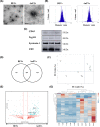Proteomic profile of extracellular vesicles in anaphylaxis and their role in vascular permeability
- PMID: 33629411
- PMCID: PMC8360103
- DOI: 10.1111/all.14792
Proteomic profile of extracellular vesicles in anaphylaxis and their role in vascular permeability
Conflict of interest statement
There are no conflicts of interest.
Figures


References
-
- Castells M. Diagnosis and management of anaphylaxis in precision medicine. J Allergy Clin. 2017;140(2):321‐333. - PubMed
-
- Jönsson F, de Chaisemartin L, Granger V, et al. An IgG‐induced neutrophil activation pathway contributes to human drug‐induced anaphylaxis. Sci Transl Med 2019;11(500):eaat1479. - PubMed
Publication types
MeSH terms
LinkOut - more resources
Full Text Sources
Other Literature Sources
Medical

